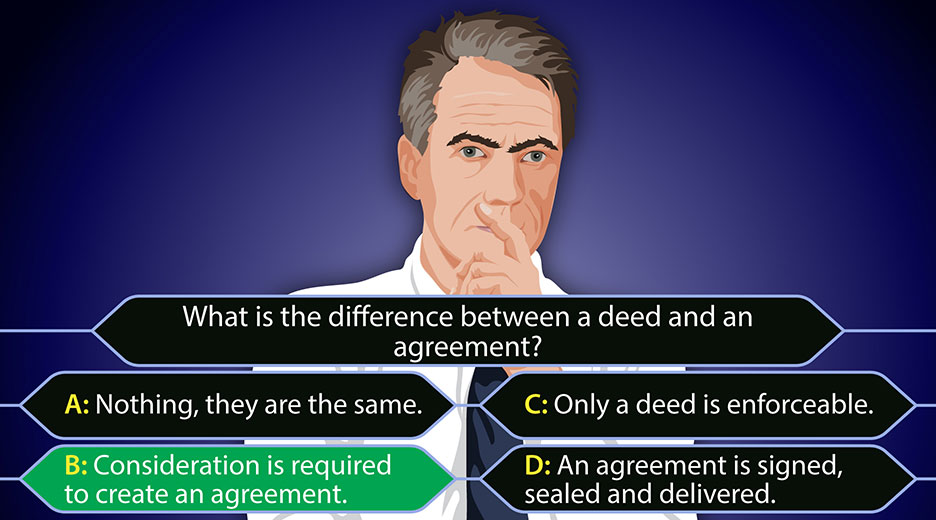What is the difference between a deed and an agreement?
Deed is a formal document that gives the clear indication that a person or entity gives its most sincere promise that they will fulfil contractual obligations.

In article:
A deed and an agreement are two types of legal instruments that are sometimes used interchangeably. However, in fact, they are two very different species and their incorrect use may have adverse consequences on certain transactions. A deed is an instrument that must be “signed, sealed and delivered”, in writing and gives the strongest indication of an intention to be bound by the terms of the document. Alternatively, an agreement can be oral and critically requires consideration to flow from one party to the other in exchange for the promise to fulfil the obligations under an agreement. The key difference between each instrument is that a deed does not require consideration for it to be legally enforceable.
What is a deed?
It is a formal document that gives the clear indication that a person or entity gives its most sincere promise that they will fulfil contractual obligations. It has the legal effect of either:
- Transferring an interest or a right in the property;
- Creating an obligation that is binding on a person or legal entity; and/or
- Confirming an act where an interest, right or property has already passed.
Historically, the requirements that set a deed apart from other legal agreement instruments was its form, legal effect and delivery. A deed, under the common law, was required to be in writing, on paper (or parchment or vellum), sealed and delivered in order to give the desired legal effect.
The form of deeds has been significantly altered by statute and the common law requirement of sealing the deed (which was once essential for the deed’s validity) is no longer is mandated. Sealing meant that a party would fix their wax seal to the deed and do an act that either expressly or impliedly acknowledging that the seal belonged to them (e.g. by expressly stated).
In New South Wales, section 38(1) of the Conveyancing Act 1919 (NSW) has altered the traditional form of a deed and states that:
“Every deed, whether or not affecting property, shall be signed as well as sealed, and shall be attested by at least one witness not being a party to the deed, but no particular form of words shall be requisite for the attestation”.
Signing (and sealing)
The key change from the traditional approach is that so long as the deed has been signed by either an individual or by a company (in accordance with section 127(3) of the Corporations Act) and witnessed by a person who is not a party to the deed, there is no requirement that it be sealed (see section 38(3) of the Conveyancing Act 1919 (NSW)).
Delivery
Another key formal aspect of the process of executing a deed is ‘delivery’. In this context, delivery does not have the meaning in the physical sense. But it does require that the legal person who is executing the deed has a clear intention to be bound by the instrument operating as a deed. A common practice is for the execution clause of a deed to begin with the words “executed as a deed” which conveys the requisite intention to be bound.
Types of deeds
There are two main types of deeds:
- Indenture –made between two or more parties with each party representing different interests (e.g. deed of release); and
- Deed poll – made by one or more persons (usually only one), however each party representing the same interest (e.g. power of attorney).
What is agreement?
An agreement (or simply a contract) does not have the strict formal requirements as a deed. The key aspects of an agreement, in accordance with contract law, are:
- Identified parties;
- Offer and acceptance (can be oral);
- Consideration;
- Certainty of terms; and
- An intention to create legal relations.
The key difference between a deed and an agreement is that consideration is not required. Consideration is a price (usually money) that is asked by a party in exchange for their promise to fulfil contractual obligations (i.e. a bargain, quid pro quo). In situations where promises are not supported by consideration (e.g. a unilateral personal guarantee) for the agreement to be legally binding it must be in the form of a deed.
Another key difference is that an agreement can be oral, whereas a deed must be in writing.
Key takeaway
In circumstances where you are unsure of whether valid consideration flows from one party to the other, the execution of a deed is the best way to ensure that the obligations under any agreement are legally binding and therefore enforceable. Further, under relevant State statutes, various transactions require a deed to be executed in order for the transaction to be valid.